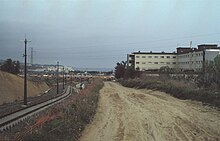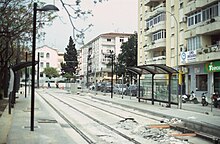Tram Vélez-Málaga
| Tram Vélez-Málaga | |
|---|---|
| Basic information | |
| Country | Spain |
| city | Vélez-Málaga |
| opening | October 11, 2006 |
| Shutdown | 4th June 2012 |
| operator | Travelsa |
| Infrastructure | |
| Formerly the largest route |
4.7 km |
| Gauge | 1435 mm ( standard gauge ) |
| Power system | 750 V DC overhead line |
| Stops | 9 |
| business | |
| Lines | 1 |
| Top speed | 70 km / h |
| statistics | |
| Passengers | 676,000 in 2011 |
| Line 4 | |||||||||||||||||||||||||||||||||||||||||||||||||||||
|---|---|---|---|---|---|---|---|---|---|---|---|---|---|---|---|---|---|---|---|---|---|---|---|---|---|---|---|---|---|---|---|---|---|---|---|---|---|---|---|---|---|---|---|---|---|---|---|---|---|---|---|---|---|
|
|||||||||||||||||||||||||||||||||||||||||||||||||||||
The Vélez-Málaga tram connected the Spanish city of Vélez-Málaga with the coastal town of Torre del Mar from October 2006 to June 2012 . Of all the Spanish tram systems built in the first decade of the 21st century , the Vélez-Málaga tram was the oldest in Andalusia . It was operated by the Travelsa company. This is the world's first shutdown of a new low-floor tram system.
history
Construction began in 2003 and on October 11, 2006 the Vélez-Málaga tram opened.
The fare for a trip was 1.30 euros. The first train departed on weekdays at 7 a.m. from the Parque Jurado Lorca stop in Vélez-Málaga and at 7:20 a.m. from the Paseo Larios stop in Torre del Mar. The last trams left Vélez at 9:40 pm and from Torre del Mar at 10:00 pm. On Saturdays, Sundays and public holidays, operations began an hour later and the last trams left Torre del Mar and at 11:00 pm at 11:20 p.m. from Vélez. The depot is located near the El Ingenio stop .
The operating line ended at the edge of the center of Vélez-Málaga, where it was necessary to change to buses to continue. As a result, the number of passengers on the tram was relatively low due to the fact that buses continued to run on the entire route without changing connections and also fell from 890,000 passengers in 2007 to 676,000 in 2011. This was to be achieved by extending the route into the center of Vélez- Malaga to be fixed. Although this line has been fully completed since 2008, it was never put into operation due to differences between the city and the operator about the participation in the operating costs.
Since 2006, the Ministry of Public Works and Transport of the Government of Andalusia has been studying the possibility of extending the route from Torre del Mar to Rincón de la Victoria . The route would have run parallel to the N-340 national road. A connection with the planned line 3 of the Málaga light rail system would have been established, the terminus of which is to be in Rincón de la Victoria.
Shutdown
After the political changes in 2011, the Partido Popular took over the government in Vélez-Málaga and closed the trams. Operations ceased on June 4, 2012, officially “temporarily” until a solution for assuming the uncovered annual operating costs of 1.7 million euros was found. This means that the Vélez-Málaga tram was in operation for less than six years, and the inner-city route never went into operation after its completion.
The government of Andalusia has meanwhile agreed with the city council to take over 40% of the tram deficit. According to the city council, resuming operations would cost 800,000 to 1,500,000 euros. So far, however, no concrete steps have been taken to resume operations.
vehicles
In Vélez-Málaga three articulated railcars of the Urbos type were used, which were manufactured by the Spanish company Construcciones y Auxiliar de Ferrocarriles (CAF). They were identical to the railways that run in Seville and the Málaga light rail system, which is under construction . The railways are standard gauge and, as bidirectional vehicles, have driver's cabs at both ends. They consist of five car bodies and have a low car floor .
The tracks are 31 meters long and can reach speeds of 70 kilometers per hour on their own track. Their capacity is 54 seats and 226 standing places (with six people per square meter).
In mid-June 2013 the wagons were prepared for transport to Sydney . Initially, the railways are going to Australia's largest city under a leasing contract. Both a purchase through Sydney and a return to Vélez-Málaga are possible under this contract.
Accidents
From its opening in 2006 to May 2009, the Vélez-Málaga tram has been involved in more than 30 traffic accidents, none of which were serious and no accident was caused by the tram.
Individual evidence
- ↑ http://www.tramvia.org/tranvias-spain/malaga.htm , Tranvías de España.
- ↑ El País : The first modern Andalusian tram goes into operation in Vélez-Málaga. (Spanish)
- ↑ City of Vélez-Málaga: timetable (PDF; 12 kB)
- ↑ El tranvía de Vélez-Málaga deja de prestar servicio este lunes debido a sus costes ( es ) 20minutos.es. June 4, 2012. Retrieved June 4, 2012.
- ↑ Dirk Budach: Spain's economic crisis hits Spanish local transport - the Vélez-Malága tram stops operating . In: Regional Rails . No. 3 , 2012, p. 46 .
- ↑ La Junta rechaza declarar el tranvía de Vélez-Málaga de interés metropolitano ( es ) sur.es. July 13, 218. Retrieved January 18, 2019.
- ↑ Working group Blickpunkt Straßenbahn e. V. (Ed.): Focus on the tram . No. 4 , 2013, ISSN 0173-0290 , p. 145 .
- ^ Diario Sur : El tranvía de Vélez-Málaga, un transporte marcado por los accidentes



